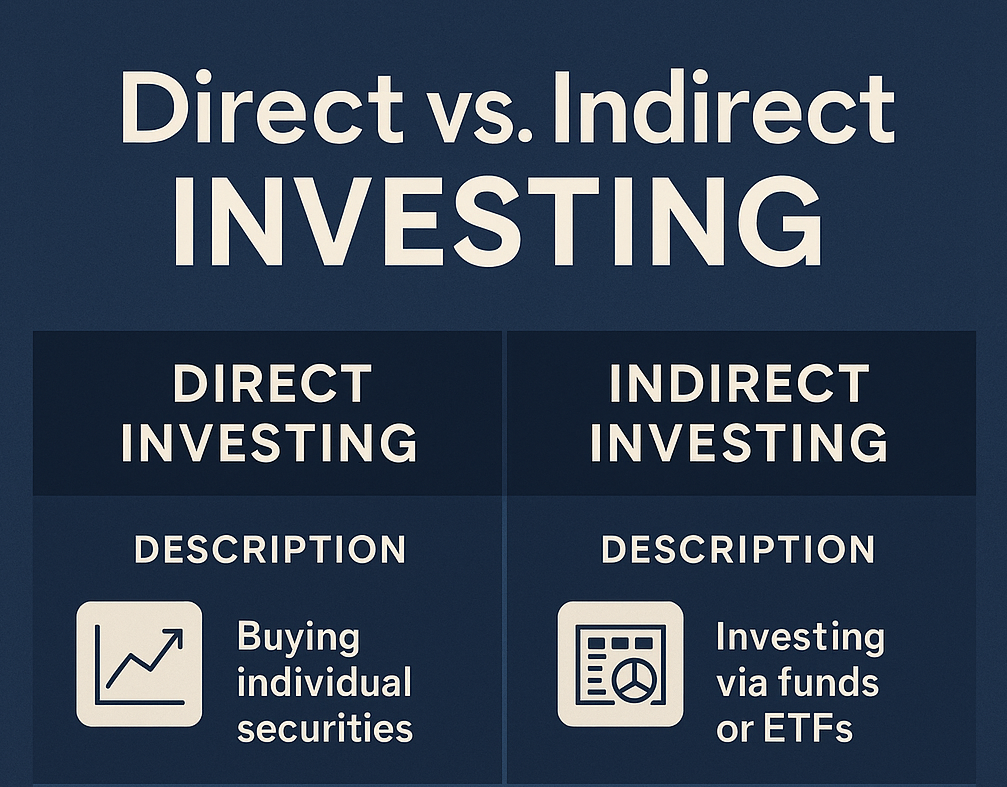
A Deep-Dive Guide on Time, Costs, Taxes, and Long-Term Strategy
One-Sentence Takeaway:
Direct investing gives you control, customization, and tax optimization, while indirect investing offers cost efficiency, diversification, and time savings. In practice, most investors achieve better outcomes with a hybrid approach: core holdings in low-cost index funds, and satellite allocations in selective direct picks.
1) Defining the Terms
- Direct Investing: Selecting and managing individual stocks, bonds, REITs, or other securities on your own.
- Indirect Investing: Using pooled products like ETFs, index funds, mutual funds, or robo-advisors.
- Hybrid (Core-Satellite): 70–90% of assets in diversified, low-cost funds (core) + 10–30% in individual ideas (satellite).
2) The Four Pillars of Decision-Making
① Time (Research/Monitoring)
- Can you dedicate 2–3 hours per week to research? → Direct Investing gains weight.
- Too busy and prefer automation? → Indirect Investing is better.
② Skill (Analysis/Discipline)
- Familiar with financial statements, valuation, and risk control? → Direct Investing
- Prefer predictable returns that match market indexes? → Indirect Investing
③ Costs & Taxes
- Expense ratios: ETFs and index funds often charge 0.03%–0.20%, while active funds are much higher.
- Trading/taxes: Direct investing may increase turnover and tax drag.
④ Goals & Preferences
- Want customization, ESG tilt, or dividend scheduling? → Direct
- Saving for retirement or education with predictability? → Indirect
3) The Power of Costs Over Time
Example: $100,000 initial, 7% annual return, 20 years:
- 0.70% expense ratio fund: $339,364
- 0.03% expense ratio ETF: $384,804
- Difference: $45,441 Add 0.5% tax drag from high turnover:
- Active, high-cost fund: $308,826
- Low-cost ETF: $384,804
- Gap: nearly $76,000
4) Direct Investing: Pros and Cons
Pros
- Full control of portfolio structure.
- Tax optimization (harvesting losses, timing gains).
- Potential for alpha (market outperformance).
Cons
- Concentration risk, lack of diversification.
- Behavioral biases: chasing news, overtrading.
- Requires time and discipline.
Best for: Investors with analysis skills, rules-based discipline, and appetite for learning. Works best when limited to 10–30% of portfolio.
5) Indirect Investing: Pros and Cons
Pros
- Low cost, broad diversification across sectors, regions, and asset classes.
- Automated rebalancing and time-saving.
- Predictable performance, especially with index funds.
Cons
- Less control over individual holdings.
- Active funds still carry high costs and underperformance risk.
- Thematic ETFs may carry hidden concentration risks.
Best for: Investors focused on long-term goals (retirement, education) who want predictable, low-cost market exposure.
6) Why Hybrid Works (Core-Satellite)
- Core (70–90%): Global equity and bond ETFs for stability.
- Satellite (10–30%): Direct ideas (stocks, REITs, thematic plays).
- Result: Balanced costs, diversification, and room for creativity.
7) Execution Checklist
- Write an Investment Policy Statement (IPS) with rules for goals, allocation, rebalancing, and stop-losses.
- Use Dollar-Cost Averaging (DCA) for consistency.
- Rebalance once or twice a year.
- Monitor fees, turnover, and tax efficiency.
- Document top risk exposures (interest rate, currency, regulation, liquidity, concentration).
8) Recommended Scenarios
- Beginners/Busy professionals: 2–3 low-cost global ETFs.
- Intermediate learners: 80% index funds + 20% direct stocks.
- High-net-worth/tax-sensitive: Direct indexing or tax-efficient ETFs.
- Thematic enthusiasts: Limit exposure to <10% of portfolio.
9) Quick Self-Check Quiz
- Can you spend 2+ hours per week on research?
- Can you stay disciplined during a 20% market drop?
- Do you pre-commit to rules on entry/exit?
- Do you understand the compounding impact of costs?
- Do you know the difference between tax-deferred and taxable accounts?
If “Yes” ≥ 4: Direct/Hybrid may fit.
If “Yes” ≤ 3: Stick to Indirect.
10) Six Common Pitfalls
- Over-concentration in few stocks.
- Trading without rules.
- Ignoring fees.
- Overlooking tax drag.
- Misunderstanding thematic ETFs.
- Skipping rebalancing.
30-Second Summary
- Direct Investing: Control, customization, and tax optimization.
- Indirect Investing: Diversification, automation, and cost savings.
- Best Real-World Approach: Core (index funds) + Satellite (direct ideas).
- Use written rules, automation, and rebalancing to avoid emotional pitfalls.
⚠️ Disclaimer: This article is for informational purposes only and does not constitute investment advice. Always consult with a financial or tax professional before making major investment decisions.
